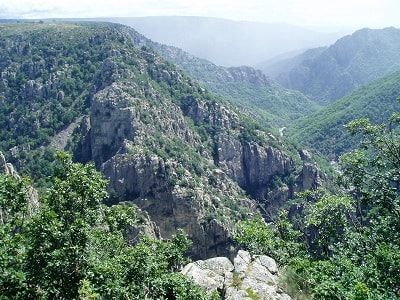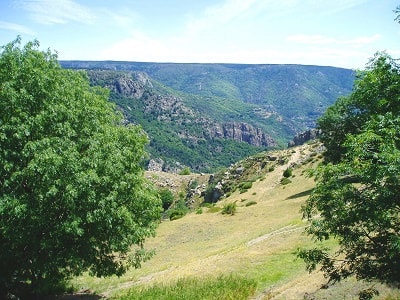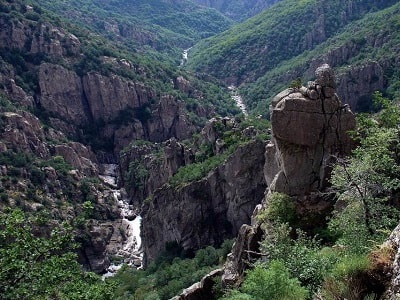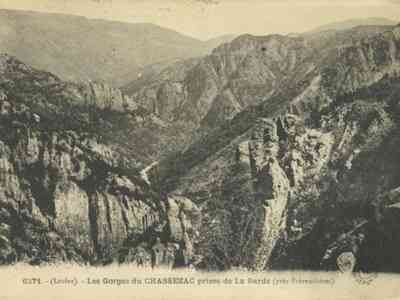The Chassezac Canyon in La Garde-Guerin |

 The Chassezac is a French river that flows through the departments of Lozere, Gard, and Ardeche. The Chassezac measures 84.6 kilometers. It originates in the Lozere department, about 20 km east of Mende, on the western slope of Moure de la Gardille (1,503 m) in the Margeride mountains, in the northern part of the commune of Saint-Frezal-d’Albuges. Its source is close to that of the Allier, which feeds the Atlantic slope and whose source is located on the eastern flank of Moure de la Gardille.
The Chassezac is a French river that flows through the departments of Lozere, Gard, and Ardeche. The Chassezac measures 84.6 kilometers. It originates in the Lozere department, about 20 km east of Mende, on the western slope of Moure de la Gardille (1,503 m) in the Margeride mountains, in the northern part of the commune of Saint-Frezal-d’Albuges. Its source is close to that of the Allier, which feeds the Atlantic slope and whose source is located on the eastern flank of Moure de la Gardille.
The Chassezac generally starts flowing south, winding in a wide loop through the commune of Saint-Frezal-d’Albuges. It serves as the southern boundary of this commune with that of Belvezet for about 2.6 km, taking a general southeastern direction that it maintains until its confluence. Downstream, it passes through the communes of Chasserades, Prevencheres, and Puylaurent. The Mirandol railway viaduct is located immediately upstream of Chasserades. Further along, it encounters the Puylaurent hydroelectric dam, shared between the communes of Prevencheres and La Bastide-Puylaurent. Its reservoir has two branches: that of the Chassezac coming from the northwest and that of the Malaval stream coming from the south and entirely located within Prevencheres.
 A main tributary of the Ardeche, it brings its waters to the right bank and is therefore a sub-tributary of the Rhône. Its gorges offer spectacular landscapes.
A main tributary of the Ardeche, it brings its waters to the right bank and is therefore a sub-tributary of the Rhône. Its gorges offer spectacular landscapes.
The fauna of the gorges is particularly varied. Among the birds, the peregrine falcon, one of the fastest birds of prey in the world, often nests in the steep cliffs, while the common buzzard hovers over the gorges in search of prey. The kingfisher, with its colorful plumage, is frequently observed near the rivers, where it catches small fish and aquatic insects.
Mammals such as wild boar and marten are common in the region. The wild boar feeds on roots, fruits, and vegetation, while the marten, agile and discreet, hunts birds and rodents in the underbrush. Occasionally, in the higher rocky areas, it is possible to spot chamois, although they are less frequent.
The gorges also shelter a variety of reptiles and amphibians, such as the ocellated lizard, often seen basking on rocks, and species of frogs and newts that inhabit the wetlands. Additionally, many insects, including butterflies, bees, and dragonflies, contribute to pollinating plants and maintaining the balance of the ecosystem.
The flora of the Chassezac gorges is equally fascinating. Mediterranean vegetation predominates, with emblematic species such as the holm oak (Quercus ilex) and the Aleppo pine (Pinus halepensis), which thrive on the sunny, dry slopes. These trees, along with shrubs such as thyme (Thymus spp.) and rosemary (Rosmarinus officinalis), add typical aromas to the region and attract numerous pollinators.
Along the rivers and in wet areas, aquatic plants such as water lilies create habitats for aquatic wildlife. Some rare and endemic species may also be found in the gorges, attesting to the unique biological richness of this region.
 The Chassezac flows through very deep granite gorges (400 m) beneath the medieval village of La Garde-Guerin, in the Cevennes National Park, 35 km east of Mende and 40 km WSW of Aubenas. The setting is extremely wild (no visible villages or roads) and merits a visit on its own. Due to its geology, the supply of drinking water at this site has always been problematic: the thin surface layer of Triassic sandstone does not allow for a sufficient reserve and protection of water in contact with the underlying granite. Within the Garde-Guerin enclosure, wells were therefore polluted in the summer. At this season or in case of a siege, the castle's cistern, dug directly into the rock at a very great depth, took over. A precious resource in the Middle Ages, rainwater was subject to a right that the lords acquired for a fee.
The Chassezac flows through very deep granite gorges (400 m) beneath the medieval village of La Garde-Guerin, in the Cevennes National Park, 35 km east of Mende and 40 km WSW of Aubenas. The setting is extremely wild (no visible villages or roads) and merits a visit on its own. Due to its geology, the supply of drinking water at this site has always been problematic: the thin surface layer of Triassic sandstone does not allow for a sufficient reserve and protection of water in contact with the underlying granite. Within the Garde-Guerin enclosure, wells were therefore polluted in the summer. At this season or in case of a siege, the castle's cistern, dug directly into the rock at a very great depth, took over. A precious resource in the Middle Ages, rainwater was subject to a right that the lords acquired for a fee.
Away from the village, the fountains were of great importance due to the flow and quality of their water until the resolution of the drinking water supply in 1938.
The Chassezac gorges were formed over millions of years by the erosion exerted by the Chassezac river. This process began in the Tertiary period when the region was subjected to significant tectonic movements. The rivers carved through the limestone and sandstone, creating steep cliffs, caves, and meanders that still characterize the landscape today. The unique geology of the region has shaped not only the landscape but also the habitat and biodiversity.
 Signs of human occupation in the region date back to prehistoric times. Archaeologists have uncovered stone tools and remnants of camps, notably in rock shelters, indicating that hunter-gatherers frequented these places. During antiquity, the region was inhabited by the Celts and later by the Romans. The Romans developed roads and infrastructure that facilitated trade and exchanges between the various regions of what is now France.
Signs of human occupation in the region date back to prehistoric times. Archaeologists have uncovered stone tools and remnants of camps, notably in rock shelters, indicating that hunter-gatherers frequented these places. During antiquity, the region was inhabited by the Celts and later by the Romans. The Romans developed roads and infrastructure that facilitated trade and exchanges between the various regions of what is now France.
In the Middle Ages, the region saw the emergence of fortified villages. La Garde-Guerin, perched on a promontory, was established as a strategic point to monitor the surrounding valleys and control access routes. The village developed an agricultural and artisanal economy, with a population that depended on the natural resources of the gorges. The presence of monks and hermits in the region attests to a strong spiritual connection with the surrounding nature.
With the arrival of the modern era, the region underwent economic transformations, notably with the rise of agriculture and industrialization. However, a large part of the population migrated to the cities, leaving behind villages that gradually declined. In the 1970s, the awareness of the importance of preserving this natural heritage led to efforts to protect the gorges and to valorize the local heritage.
From the 1980s onwards, the Chassezac gorges began to attract the attention of nature lovers and outdoor activities. The development of tourist infrastructures, such as hiking trails and climbing sites, revitalized the local economy while preserving the environment. Today, the gorges are recognized as an ecologically important site and are integrated into conservation initiatives.
Former holiday hotel with a garden along the Allier, L'Etoile Guest House is located in La Bastide-Puylaurent between Lozere, Ardeche, and the Cevennes in the mountains of Southern France. At the crossroads of GR®7, GR®70 Stevenson Path, GR®72, GR®700 Regordane Way, GR®470 Allier River springs and gorges, GRP® Cevenol, Ardechoise Mountains, Margeride. Numerous loop trails for hiking and one-day biking excursions. Ideal for a relaxing and hiking getaway.
Copyright©etoile.fr